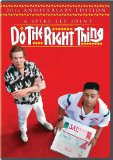| Reviews & Columns |
|
Reviews DVD TV on DVD Blu-ray 4K UHD International DVDs In Theaters Reviews by Studio Video Games Features Collector Series DVDs Easter Egg Database Interviews DVD Talk Radio Feature Articles Columns Anime Talk DVD Savant Horror DVDs The M.O.D. Squad Art House HD Talk Silent DVD
|
DVD Talk Forum |
|
|
| Resources |
|
DVD Price Search Customer Service #'s RCE Info Links |
|
Columns
|
|
|
Do the Right Thing - 20th Anniversary Edition (2-Disc Set)
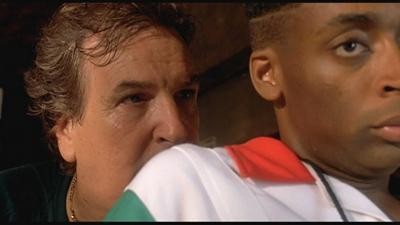 Do the Right Thing takes place in Brooklyn's Bedford-Stuyvesant on the hottest day of the summer. The film was contemporary when it was released in 1989, but it doesn't really matter; writer/director Spike Lee's cast of characters are all defined in a modern, but otherwise timeless way. Lee's film has an ear for the way people act and sound, capturing the spirit of real life through the overwhelming richness of its characterizations and setting. You've known (or know) people like this, you've lived (or live) in a similar place, and reacting to it is almost reflex. Then, in the last twenty minutes, Lee yanks the carpet out from under the audience, capitalizing on that familiarity by dropping a perfect storm of sorts on these characters we've come to like, and 20 years on, the result will still divide people like few other films I can think of.
Do the Right Thing takes place in Brooklyn's Bedford-Stuyvesant on the hottest day of the summer. The film was contemporary when it was released in 1989, but it doesn't really matter; writer/director Spike Lee's cast of characters are all defined in a modern, but otherwise timeless way. Lee's film has an ear for the way people act and sound, capturing the spirit of real life through the overwhelming richness of its characterizations and setting. You've known (or know) people like this, you've lived (or live) in a similar place, and reacting to it is almost reflex. Then, in the last twenty minutes, Lee yanks the carpet out from under the audience, capitalizing on that familiarity by dropping a perfect storm of sorts on these characters we've come to like, and 20 years on, the result will still divide people like few other films I can think of.
I had not seen Do the Right Thing before I watched it for this review (even though I own a copy -- just hadn't gotten around to it), and it took me a few days before I thought I had things figured out enough to start writing. Is it troubling? Yes and no. Lots of movies show you scenarios that might be called "troubling" or "challenging", but they're usually hard to swallow because they're clear-cut: a character dies of cancer; a child is killed; a spouse leaves; the hero dies. Lee's movie is different. 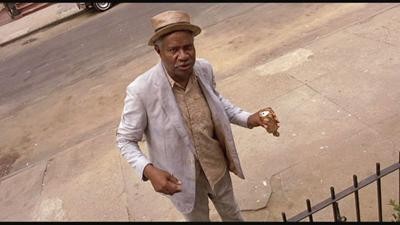 Built-up tensions boil over, and people reach their personal breaking points, but the audience has an objective perspective, and they're stuck in their seats, unable to settle an outburst that could've and should've been presented. It's rare that a movie will get more than a basic reaction out of the viewer, but Do the Right Thing has enough going on to chew on for weeks.
Built-up tensions boil over, and people reach their personal breaking points, but the audience has an objective perspective, and they're stuck in their seats, unable to settle an outburst that could've and should've been presented. It's rare that a movie will get more than a basic reaction out of the viewer, but Do the Right Thing has enough going on to chew on for weeks.
What makes this movie special is that it's so easy to see where each of the characters are coming from (if not necessarily agree). We have Sal (Danny Aiello), a pizzeria owner who takes constant flak from his son Pino (John Turturro) about running his restaurant in a primarily black neighborhood, but Sal likes his customers, and his customers like him, except for Buggin Out (Giancarlo Esposito), who complains about the amount of cheese on his dollar-fifty slice and picks on Sal's Wall of Fame, featuring photographs of various famous Italian-Americans but no black celebrities. Sal kicks him out for complaining, telling him to get his own pizzeria and do what he wants with it, but Buggin Out wanders around town trying to form a boycott. When it doesn't work, he instead pesters an innocent biker (John Savage) on the steps of his home after he carelessly runs into Buggin Out and steps on his shoes.
Meanwhile, Mookie (Lee), Sal's pizza delivery boy, is just trying to get through the day. Mookie is a bit of a drifter. He seems to enjoy his job, and he certainly enjoys earning his own money, but he doesn't have any clearly-defined goals, and he resists Sal's authority by taking detours and extended breaks while delivering pizzas, much to the annoyance of his sister Jade (Joie Lee). Mookie is also hounded by his girlfriend, Tina (Rosie Perez), with whom he has a baby, and Pino, who picks on both Mookie and his brother Vito (Richard Edson). Mookie and Vito have a good relationship, 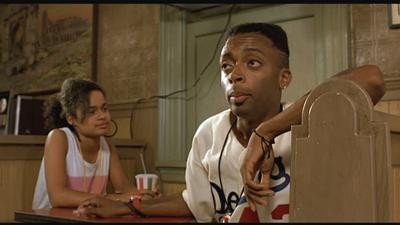 and Mookie tells Vito to stand up to Pino and fight him off, which only deepens Pino's dislike for Mookie.
and Mookie tells Vito to stand up to Pino and fight him off, which only deepens Pino's dislike for Mookie.
Out watching the streets, we have Da Mayor (Ossie Davis), who wanders around drinking and tries to gain some friendly traction with Mother Sister (Ruby Dee), who sits in her windowsill and scoffs at him; a trio of old men (Paul Benjamin, Frankie Faison and Robin Harris), who sit on the corner of the street and wonder what happened to their ambitious goals in life, and Smiley (Roger Smith), a mentally handicapped man trying to sell photographs to people. The last piece of the puzzle is Radio Raheem (Bill Nunn), who wanders around town with his gigantic boombox, blasting Public Enemy's "Fight the Power" 24/7. Despite his dour expression, Radio Raheem seems content to wander aimlessly playing his music, but kids playing other music, dying batteries, and Sal all stand in his way.
Lee's direction is mostly straightforward; what's impressive is how assured his control over the movie's tone is even though Do the Right Thing is only his third feature film. He's got a few stylistically stand-out moments: Rosie Perez dancing furiously over the movie's opening credits, the infamous montage of racist slurs where the characters talk directly into the camera, and one of the most tender, intimate sex scenes I can remember seeing in a movie. But it's all about the realism of the neighborhood, and the connection formed between the audience and the characters. If it weren't for the movie's explosive conclusion, I could have watched the characters of Do the Right Thing go on living their lives for days and days.
After the movie was over, I glanced at the Wikipedia to see if it offered any more clear-cut answers. 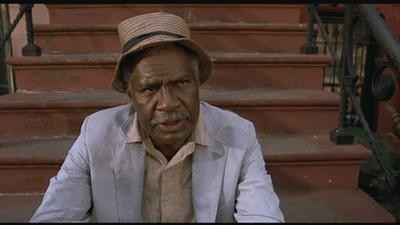 In a sense, it does: the page mentions Lee's own feelings about the film in regards to the way it plays out, and his thoughts on people who disagree with his point of view. Do the Right Thing's great trick is that it gives the audience enough room to arrive on one side of the film's built-in debate or the other, and somehow those reactions, despite occurring outside of the film itself, are almost part of its commentary. The film's explosive ending is a perfect distillation of real-world events, simultaneously tapping into the same cultural biases that come up when those tragedies occur with an incredible skill. The film really is a Rorschach test for its audience members. The film is a real Rorschach test: it will reflect whatever you bring to it, and provides a chance for the viewer to learn something from that reaction.
In a sense, it does: the page mentions Lee's own feelings about the film in regards to the way it plays out, and his thoughts on people who disagree with his point of view. Do the Right Thing's great trick is that it gives the audience enough room to arrive on one side of the film's built-in debate or the other, and somehow those reactions, despite occurring outside of the film itself, are almost part of its commentary. The film's explosive ending is a perfect distillation of real-world events, simultaneously tapping into the same cultural biases that come up when those tragedies occur with an incredible skill. The film really is a Rorschach test for its audience members. The film is a real Rorschach test: it will reflect whatever you bring to it, and provides a chance for the viewer to learn something from that reaction.
"Doctor!" Da Mayor flags Mookie down. "Always do the right thing," he advises. "That's it?" asks Mookie. "That's it," Da Mayor replies. Mookie nods. "I got it, I'm gone." It sounds simple, but it proves to be a challenge. Originally, Do the Right Thing was called Heat Wave, but the final title fits so much better. Do the characters do the right thing? Considering it, as I have, for several days, I have to say that regardless of how you feel, it's the kind of thinking and discussion (internal or external) only a special film provides. The movie starts out by introducing us to a neighborhood so alive and observant that the movie would be great without its ending, but the extra step makes it a masterpiece. "Always do the right thing," says Da Mayor. Mookie tries his best, as does everyone on the block, but it's hot out there today, and it's only going to get hotter tomorrow.
The DVD
Do the Right Thing comes in a standard-sized 2-disc case with a flap tray. The cover is predominantly red, erasing the original blue of the poster art and children drawing with sidewalk chalk to isolate Sal and Mookie, staring up at the camera. It's striking, and the design is clean and readable, but it feels like one other element might have really made it eye-catching. There is no insert, the discs are silver with ink only for the titles logos, and the menus are all still-frames and easy to navigate.
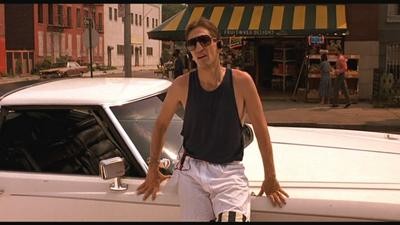 The Video
The Video
Most people know about the very old, stand-alone, letterboxed Universal disc and the anamorphic Criterion release, but Universal also slipped an anamorphic version onto the market a few years ago with The Spike Lee Joint Collection, which is the one I've had and hadn't gotten a chance to watch. Comparing the two 1.85:1 anamorphic widescreen presentations while listening to the commentary, I couldn't see any noticeable difference. Both transfers are clean and rich with fine detail, exhibiting a nice sense of depth and clarity, and I didn't notice any print damage. A poster on the message boards here at DVDTalk complained that Ernest Dickerson's orange cinematography had been washed away on the Blu-ray, and admittedly I don't have the original Universal nor the Criterion disc (approved by Dickerson) to compare these transfers to, but on my TV, the film looked nice and saturated with a sweltering reddish tint.
UPDATE (6/24/09): Here is a DVD Beaver comparison between the Criterion and the Blu-ray (which features the same transfer as the DVD), so you can judge for yourself (the last of the images could be considered a partial major spoiler, though).
UPDATE (6/25/09): Since yesterday, the debate over how relevant the cinematography issues on this DVD have increased, so I'm updating this section again with my own, more detailed thoughts on the matter.
As I mentioned at the start of this review, this was my first time seeing Do the Right Thing, which is probably the number one factor in the way I feel about this DVD presentation. The color issue is absolutely an artistic concern and should be addressed. Spike Lee is apparently doing a signing in New York City to promote this DVD, and I'm sure he'll do others, so I certainly encourage anyone at that event to bring the issue up to him, not to mention contact Universal using this form and let them know your thoughts on the DVD's color timing.
That said, as a first-time viewer, I have a hard time believing this alteration significantly changed the way I watched the movie. I still understood that it was hot, I could still feel it watching the film (I hate the heat, so I immediately fell into that mindset), and again, there are still plenty of shots in the movie that exhibit a noticeable orange tint. It's just like the debate over the color timing on Halloween (which, for the record, currently remains unresolved). I can see why it's a dealbreaker for people, and it's absolutely something important to discuss and address with the studio and whoever else can be asked about it, but as with any DVD issue that doesn't concern the outright editing of scenes in or out of the movie, my personal feeling is that the issue should be addressed on a case-by-case basis, and, in this case, it didn't appear to change, for me, what Spike Lee had in mind when he wrote and directed the film.
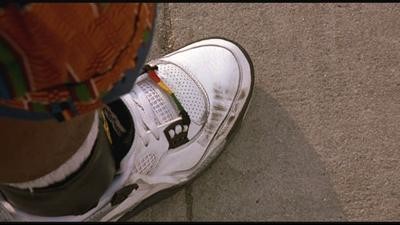 If Universal responds by correcting the transfer and pressing new discs, I will certainly change this review and encourage people to buy the corrected transfer, but I stand by my Collector's Series rating because everything else about the disc -- the qualities of the transfer outside the color timing, the audio, the special features, the price -- is excellent. Ultimately, compared to the issue with Let the Right One In, where alternate subtitles actually alters the characterization of the of the characters through the dialogue, or, again, some sort of outright film editing or censorship, I did and still do leave this up to the prerogative of the viewer, mainly because the relevant things conveyed by the timing (the heat) were, in my opinion, adequately expressed through other factors in the movie.
If Universal responds by correcting the transfer and pressing new discs, I will certainly change this review and encourage people to buy the corrected transfer, but I stand by my Collector's Series rating because everything else about the disc -- the qualities of the transfer outside the color timing, the audio, the special features, the price -- is excellent. Ultimately, compared to the issue with Let the Right One In, where alternate subtitles actually alters the characterization of the of the characters through the dialogue, or, again, some sort of outright film editing or censorship, I did and still do leave this up to the prerogative of the viewer, mainly because the relevant things conveyed by the timing (the heat) were, in my opinion, adequately expressed through other factors in the movie.
UPDATE (11/05/11): It's been brought to my attention that a poster over at the Home Theater Forum managed to get ahold of cinematographer Ernest Dickerson, who confirmed that the transfer on the 20th Anniversary Blu-ray and DVD was supervised and approved by both himself and Spike Lee (post here).
The Audio
Aside from the beats of "Fight the Power", the immersion of the Dolby 5.1 audio is subtle, but effective. Most of the film takes place outside, and you certainly feel like you're standing on your own street corner, listening to the cars pass by. Dialogue is crisp, coming through the front channels, and I didn't hear any hissing or pops. Do the Right Thing is not an aural tour-de-force, but the mix gets the job done effectively. Spanish and French 5.1 are also provided, along with English, French and Spanish subtitles.
The Extras
Any fan of Do the Right Thing is in for a treat: Universal has licensed all but two of the Criterion's extras for this new 20th Anniversary Edition (those extras being the "Fight the Power" music video, which had a Lee commentary, and "Spike's Last Word"). On top of the extensive features from that set, they've packed in some new material. It's not as essential as Criterion's material, but you can't argue with the added effort Universal's put into this set.
Digging into the new material first, we start off with "Do the Right Thing: 20 Years Later" (35:46), a documentary directed by Lee himself. All of the material appears to have been filmed before, during and after a 2009 screening of the film, with participation of cinematographer Ernest Dickerson, line producer Jon Kilik, and actors Rosie Perez, John Turturro, Richard Edson, Roger Smith, Frankie Faison, John Savage, Steve Park and Luis Ramos. 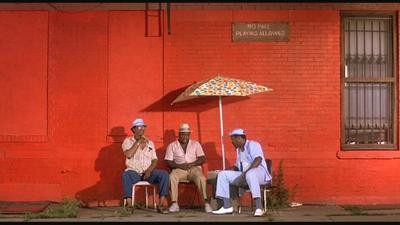 Lee asks them questions from behind the camera and some have their comments lifted from the Q+A, and they chat about how they got involved and their process making the movie. It's a friendly but not particularly incisive piece, and the perspectives of key players like Danny Aiello, Giancarlo Esposito and Bill Nunn are sorely missed (not to mention Lee himself also doesn't sit in front of the camera much). Worth a spin, but expect more of a friendly reunion than a cutting deconstruction.
Lee asks them questions from behind the camera and some have their comments lifted from the Q+A, and they chat about how they got involved and their process making the movie. It's a friendly but not particularly incisive piece, and the perspectives of key players like Danny Aiello, Giancarlo Esposito and Bill Nunn are sorely missed (not to mention Lee himself also doesn't sit in front of the camera much). Worth a spin, but expect more of a friendly reunion than a cutting deconstruction.
Next, we have a gallery of 11 newly-discovered deleted and extended scenes (14:14). They're mostly "flavor" scenes, including Martin Lawrence and his friend dancing on the roof, a kid frying an egg on Sal's Cadillac, and Mookie and Vito hanging out at Love Daddy's radio station, so if these deleted scenes are the one and only reason you're planning to pick up this disc, I'd say rent it instead, but the last one, a slightly longer closing scene between Sal and Mookie in which Sal repeats Da Mayor's titular advice, is an interesting alternate final beat.
Two major extras follow: an all-new 20th anniversary audio commentary with Lee flying solo, and the original Criterion commentary, which gathers Lee, DP Ernest Dickerson, production designer Wynn Thomas and actress Joie Lee (Spike's sister). The new track features some familiar stories, and there's some dead space, but Lee seems pleased to look back on the film, and has more personal stories and perspective to offer than he does elsewhere. It gets a little spotty between the second and third acts, but near the end and through the credits, Lee starts talking again. In keeping with all the Criterion efforts I've heard, the second track is edited together from separate recording sessions with each participant, which creates a nice "cream-of-the-crop" scenario where there isn't any dead space and the comments are almost always interesting. 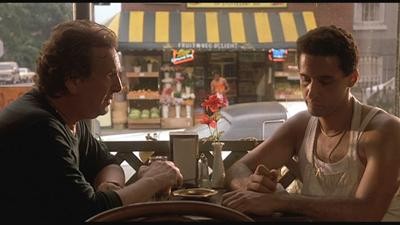 A slight downside is the Criterion track isn't truly scene-specific (except for Lee), although of course the editors have tried to cut in the comments at pertinent moments. I hate to generalize, but personally, I prefer hearing various points of view, so if I had to choose, I'd give the edge to the group chat, but both are pretty good.
A slight downside is the Criterion track isn't truly scene-specific (except for Lee), although of course the editors have tried to cut in the comments at pertinent moments. I hate to generalize, but personally, I prefer hearing various points of view, so if I had to choose, I'd give the edge to the group chat, but both are pretty good.
Disc 1 rounds out with a theatrical trailer (2:13) and two TV spots (0:32 each).
On Disc 2, we have several sections, starting with the vaguely-titled "Behind the Scenes", which contains the the first of many "Spike Lee Intro" (1:43) segments, "The Read-Through (19:04), "Developing Character" (6:39), "Rehearsals" (16:06), "Improvising With the Cornermen" (6:23) and "Block Party" (8:06), with a "Play All" option (total 57:57). Sure, the sound isn't great, the video's washed out and the camerawork is shaky, but this wealth of pre-production footage (shot by Lee's brother David) is a fascinating look at the movie's excellent cast (including then-novice performers Turturro, Lawrence and Perez) getting into the roles and working their characters out. The footage includes a read-through of the script and the cast's reactions to it, several hilarious candid clips of Lee asking the cast (mostly Perez) random questions, all the way through to the wrap party, during which Lee is showered with sports gifts. Why more DVDs don't try to capture more fly-on-the-wall footage like this, I have no idea, because it's the kind of funny, candid stuff you never get to see.
The next option is "Making Do the Right Thing", which includes the documentary by the same name, another "Spike Lee Intro" (0:49), and an epilogue called "Back to Bed-Stuy" (4:50). The doc is broken up into several further pieces: "Message to the Community" (5:34), "Bed-Stuy, Do or Die" (4:48), "American-Italian-Americans" (8:07), "'One of My Mentors'" (3:56), "Production Begins" (7:38), "Extra Casting" (7:33), "A Little Inconvenience" (5:51), "'Not That I'm Prejudiced'" (3:43), "In Search of An Answer" (7:00) and "That's a Wrap" (6:54), again with a "Play All" option (total 1:00:59). It's not as focused as I was expecting, but it's still an engaging featurette that touches on the Howard Beach incident that inspired the screenplay, the challenges of working in the real Bed-Stuy neighborhood, and the full range of reactions from the area's residents on the filming, from the positive to the negative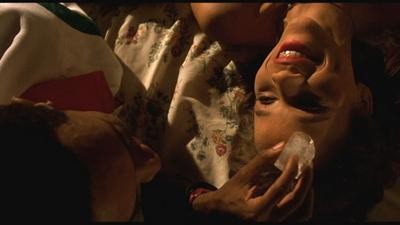 (the film production offers jobs to residents but often requires people to stay indoors while the camera is rolling). The doc is followed by the "Back to Bed-Stuy" bit, which is a recent return to the neighborhood led by Spike and Jon Kilik. Not too informative, but a nice then-and-now perspective.
(the film production offers jobs to residents but often requires people to stay indoors while the camera is rolling). The doc is followed by the "Back to Bed-Stuy" bit, which is a recent return to the neighborhood led by Spike and Jon Kilik. Not too informative, but a nice then-and-now perspective.
"Editor Barry Brown" leads to four segments, titled "Meeting Spike" (2:57), "Beautifully Composed" (2:14), "Roll-Call Sequence" (2:00) and "On the Set" (2:30), once again with a "Play All" option (total 9:39). It's an interesting little interview, although I'm not sure why Brown was given his own special interview. "The Riot Sequence" is next, an interactive storyboard gallery with another "Spike Lee Intro" (1:31). The intro is actually more interesting than the storyboards themselves (I've never cared much for them -- see one storyboard, you've seen 'em all), with Spike explaining briefly why he chose to storyboard the sequence and his thoughts on the process.
Lastly, "Cannes, 1989" leads to one last gallery of clips, titled "Introductions" (3:09), "Sal and Violence" (5:53), "Davis, Spike and the Industry" (1:37), "Black Perspective/Public Enemy" (3:15), "Discussing the Characters" (4:29), "Summer of '89" (2:26), "Filmmaking and Race" (3:20), "Life vs. Art" (5:22), "Mookie" (1:47), "Filmmaker's Aren't Gods" (3:30), "'This Film is Not About Drugs'" (3:13) and "'White Flight'" (4:27), with, yes, a "Play All" option (total 42:21). The footage is taken from the festival panel following the film's premiere, featuring Spike Lee, Ossie Davis, Richard Edson, Ruby Dee and Joie Lee, hosted by Henri Behar. It's surprisingly awkward; Spike usually has a fairly laid-back, slow demeanor, and here, he speaks even more slowly, picking his words carefully as he gives some of the most no-nonsense, take-no-prisoners statements you'll find on the disc. For this reason alone it's an interesting historical document, but watching it is a little uncomfortable. Amusingly, once Lee starts, 90% of the questions are directed solely at him (Richard Edson, Ruby Dee and Joie Lee only answer a single question each).
All but one of the features are subtitled in English, French and Spanish, which is excellent as the sound quality is a little spotty on some of the footage. The lone holdout feature is Lee's new audio commentary, which is strange. 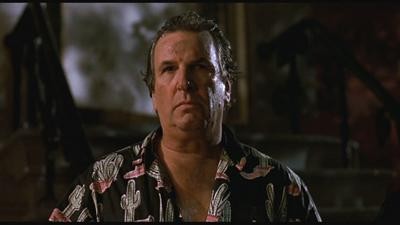 If anything, I'd have expected things to be vice-versa, but what do I know?
If anything, I'd have expected things to be vice-versa, but what do I know?
Conclusion
Do the Right Thing is an outstanding piece of modern filmmaking that's both vividly entertaining with terrific performances from a stellar cast and deeply challenging through sharp writing in equal measure. It will send people off to ponder what they've seen, and most of them will almost certainly come back rewarded by the things they've considered, bearing an additional layer of respect for the movie itself. The DVD itself is just as good: the picture looks pristine (as far as I can tell), the sound is solid and the extras are great (except for the admittedly disappointing omission of the "Fight the Power" music video and "Spike's Last Word"). If you've got the Criterion, you can probably just rent the first disc, which contains all three of the new extras, but for anyone else, this set merits inclusion in the DVDTalk Collector's Series, as this is that DVD, only better and cheaper, and the film is as potent as ever.
UPDATE: The difference in color timing in the Universal and Criterion transfers is a relevant issue, as it was certainly an artistic choice on the part of Lee and cinematographer Ernest Dickerson (who approved Criterion's transfer), but is it a dealbreaker? Seeing as the film lost none of its thematic impact for myself upon first viewing, I have a hard time saying that it does, but this is certainly the kind of debate that Halloween fans know like the backs of their hands. All in all, I'm not altering my review scores, but I have added the DVDBeaver comparison so that potential consumers can decide on their own.
In the meantime, remember: today's word of the day is "chill", c-h-i-l-l, and always do the right thing. That's it. I'm gone.
Please check out my other DVDTalk DVD, Blu-ray and theatrical reviews and/or follow me on Twitter.
|
| Popular Reviews |
| Sponsored Links |
|
|
| Sponsored Links |
|
|
| Release List | Reviews | Shop | Newsletter | Forum | DVD Giveaways | Blu-Ray | Advertise |
|
Copyright 2024 DVDTalk.com All Rights Reserved. Legal Info, Privacy Policy, Terms of Use,
Manage Preferences,
Your Privacy Choices | |||||||









